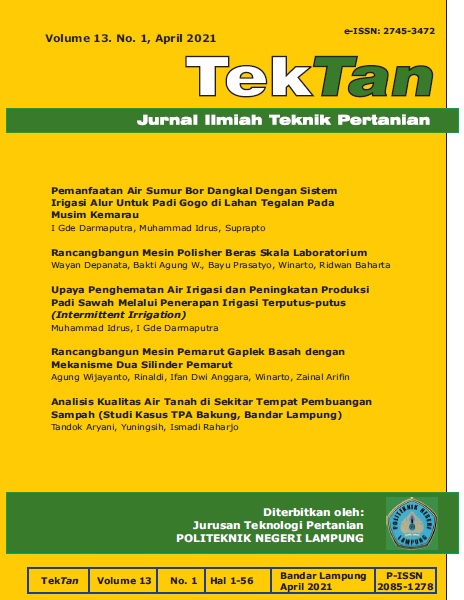A Pemanfaatan Air Sumur Bor Dangkal Dengan Sistem Irigasi Alur Untuk Padi Gogo di Lahan Tegalan Pada Musim Kemarau
Abstrak
Effort of expansion and increasing of planting intensity of upland rice in Lampung Province can be done by adding irrigation. The source of irrigation water can come from the shallow well using furrow irrigation technology. What is the furrow distance that results high water use efficiency and optimal water productivity for upland rice? This study aims: 1) to measure the amount of upland rice irrigation water usage at various furrow distances, 2) to measure plant growth and 3) determine the optimal distance of furrow irrigation. The experiment was arranged in a randomized block design with the furrow distances treatment at three levels: 60, 80, and 120 cm. Each treatment was repeated three times. The variables observed were soil moisture, the amount of irrigation water use and plant growth. Analysis of data using ANOVA at a significant difference test level of 5%. The results showed that the different furrow distance had no significant effect on the growth of upland rice. This can be caused by the soil moisture in the root zone was still in the range of readily available water, i.e. 26.9-39.4% before giving irrigation. The mean plant height at 70 days after planting in the treatment of furrow distances 60, 80 and 120 cm were 107.1, 104.1, and 106.9 cm respectively, but significantly different from the control (without irrigation) was only 86.4 cm. The number of upland rice tillers at 70 days after planting in the all treatments and control was not significantly different, i.e. in the range 20.5-25.3 stems per clump. The average irrigation water used up to 70 days after planting at the furrow distance 60, 80, and 120 cm were 733, 735, and 490 mm respectively.Unduhan
Data unduhan belum tersedia.
##submission.downloads##
Diterbitkan
2021-12-28
Cara Mengutip
Darmaputra, I. gde. (2021). A Pemanfaatan Air Sumur Bor Dangkal Dengan Sistem Irigasi Alur Untuk Padi Gogo di Lahan Tegalan Pada Musim Kemarau. Jurnal Ilmiah Teknik Pertanian - TekTan, 13(1), 1-9. Diambil dari https://jurnal.polinela.ac.id/TEKTAN/article/view/2226
Terbitan
Bagian
Artikel



